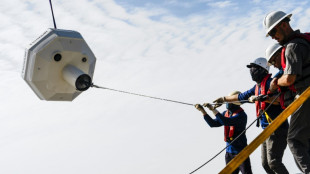
-
 Syria authorities say torched 1 million captagon pills
Syria authorities say torched 1 million captagon pills
-
Pope calls for 'arms to be silenced' across world

-
 32 survivors as Azerbaijani jet crashes in Kazakhstan
32 survivors as Azerbaijani jet crashes in Kazakhstan
-
Pakistan air strikes kill 46 in Afghanistan, Kabul says

-
 Liverpool host Foxes, Arsenal prepare for life without Saka
Liverpool host Foxes, Arsenal prepare for life without Saka
-
Zelensky condemns Russian 'inhumane' Christmas attack on energy grid

-
 Sweeping Vietnam internet law comes into force
Sweeping Vietnam internet law comes into force
-
Pope kicks off Christmas under shadow of war

-
 Catholics hold muted Christmas mass in Indonesia's Sharia stronghold
Catholics hold muted Christmas mass in Indonesia's Sharia stronghold
-
Japan's top diplomat in China to address 'challenges'

-
 Thousands attend Christmas charity dinner in Buenos Aires
Thousands attend Christmas charity dinner in Buenos Aires
-
Demand for Japanese content booms post 'Shogun'

-
 As India's Bollywood shifts, stars and snappers click
As India's Bollywood shifts, stars and snappers click
-
Mystery drones won't interfere with Santa's work: US tracker

-
 Djokovic eyes more Slam glory as Swiatek returns under doping cloud
Djokovic eyes more Slam glory as Swiatek returns under doping cloud
-
Australia's in-form Head confirmed fit for Boxing Day Test

-
 Brazilian midfielder Oscar returns to Sao Paulo
Brazilian midfielder Oscar returns to Sao Paulo
-
'Wemby' and 'Ant-Man' to make NBA Christmas debuts

-
 US agency focused on foreign disinformation shuts down
US agency focused on foreign disinformation shuts down
-
On Christmas Eve, Pope Francis launches holy Jubilee year

-
 'Like a dream': AFP photographer's return to Syria
'Like a dream': AFP photographer's return to Syria
-
Chiefs seek top seed in holiday test for playoff-bound NFL teams

-
 Panamanians protest 'public enemy' Trump's canal threat
Panamanians protest 'public enemy' Trump's canal threat
-
Cyclone death toll in Mayotte rises to 39

-
 Ecuador vice president says Noboa seeking her 'banishment'
Ecuador vice president says Noboa seeking her 'banishment'
-
Leicester boss Van Nistelrooy aware of 'bigger picture' as Liverpool await

-
 Syria authorities say armed groups have agreed to disband
Syria authorities say armed groups have agreed to disband
-
Maresca expects Man City to be in title hunt as he downplays Chelsea's chancs

-
 South Africa opt for all-pace attack against Pakistan
South Africa opt for all-pace attack against Pakistan
-
Guardiola adamant Man City slump not all about Haaland

-
 Global stocks mostly higher in thin pre-Christmas trade
Global stocks mostly higher in thin pre-Christmas trade
-
Bethlehem marks sombre Christmas under shadow of war

-
 11 killed in blast at Turkey explosives plant
11 killed in blast at Turkey explosives plant
-
Indonesia considers parole for ex-terror chiefs: official

-
 Postecoglou says Spurs 'need to reinforce' in transfer window
Postecoglou says Spurs 'need to reinforce' in transfer window
-
Le Pen says days of new French govt numbered

-
 Villa boss Emery set for 'very difficult' clash with Newcastle
Villa boss Emery set for 'very difficult' clash with Newcastle
-
Investors swoop in to save German flying taxi startup

-
 How Finnish youth learn to spot disinformation
How Finnish youth learn to spot disinformation
-
12 killed in blast at Turkey explosives plant

-
 Panama leaders past and present reject Trump's threat of Canal takeover
Panama leaders past and present reject Trump's threat of Canal takeover
-
Hong Kong police issue fresh bounties for activists overseas

-
 Saving the mysterious African manatee at Cameroon hotspot
Saving the mysterious African manatee at Cameroon hotspot
-
India consider second spinner for Boxing Day Test

-
 London wall illuminates Covid's enduring pain at Christmas
London wall illuminates Covid's enduring pain at Christmas
-
Poyet appointed manager at South Korea's Jeonbuk

-
 South Korea's opposition vows to impeach acting president
South Korea's opposition vows to impeach acting president
-
The tsunami detection buoys safeguarding lives in Thailand

-
 Teen Konstas to open for Australia in Boxing Day India Test
Teen Konstas to open for Australia in Boxing Day India Test
-
Asian stocks mostly up after US tech rally


On Galapagos Islands, Darwin's flycatcher makes a tiny comeback
Darwin's flycatcher, a small bird with striking vermilion plumage, is making modest but noticeable headway on the Galapagos Islands in its battle back from near extinction, the remote archipelago's national park said Thursday.
The only 15 remaining pairs of the charismatic birds on the island of Santa Cruz have produced 12 chicks this year, the park said.
The species is endemic to the Galapagos, and is considered vulnerable by the International Union for Conservation of Nature (IUCN).
Darwin's flycatchers reside on other islands in the chain, like Pinzon, but their population was particularly threatened on Santa Cruz Island.
An experimental management program there "permitted 12 new chicks to add to the population" in a forest at higher elevation on Santa Cruz, where only 15 pairs exist, the Galapagos National Park said.
The reserve's director, Danny Rueda, said that "each chick that is born is a new hope to save this species that is vulnerable and on the red list."
"These 12 new birds constitute a veritable success since initiating the program in 2018 and finally getting results, never more so than this year," the park said.
The program, a joint project with the Charles Darwin Foundation, the University of Vienna and the nonprofit Galapagos Conservancy, has seen 21 chicks arrive on Santa Cruz between 2020 and 2022, it said.
The Galapagos archipelago, some 1,000 kilometers (600 miles) off the coast of Ecuador, has flora and fauna found nowhere else in the world. Observing its wonders led British scientist Charles Darwin to develop his theory of evolution in the 19th century.
P.Cavaco--PC




